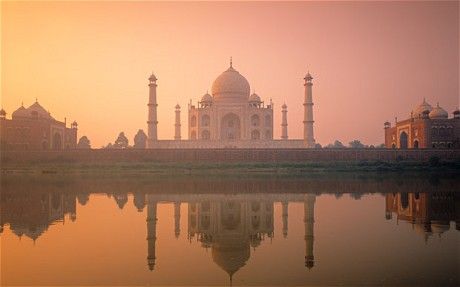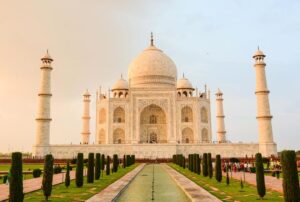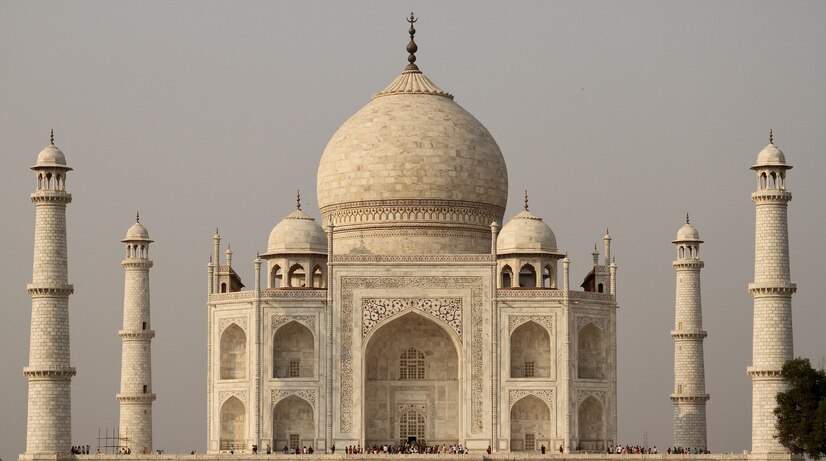The Majestic Taj Mahal: A Timeless Testament of Love and Beauty
The Taj Mahal, often hailed as the epitome of love and architectural brilliance, stands as a symbol of India’s rich history and cultural heritage. This magnificent mausoleum attracts millions of visitors from around the world, all eager to witness its ethereal beauty and learn about its fascinating history
The Love Story Behind the Taj Mahal
The Taj Mahal was commissioned in 1632 by the Mughal Emperor Shah Jahan in memory of his beloved wife Mumtaz Mahal. The emperor’s deep love for Mumtaz Mahal is immortalized in this white marble masterpiece, which took over 20 years to complete. The love story of Shah Jahan and Mumtaz Mahal is one of the most romantic tales in history, and the Taj Mahal stands as a testament to their eternal love.

A Glimpse into History
Construction and Architecture
The construction of the Taj Mahal began in 1632 and was completed in 1653. It involved the labor of over 20,000 workers and artisans from India, Persia, and the Ottoman Empire. The Taj Mahal’s design is a blend of Islamic, Persian, and Indian architectural styles, showcasing intricate carvings, stunning marble inlay work, and a perfectly symmetrical layout.
Architectural Marvel
The Taj Mahal’s stunning white marble structure is adorned with precious gemstones, intricate carvings, and calligraphy. The central dome, standing at 73 meters, is surrounded by four smaller domes and four slender minarets, all contributing to its harmonious proportions. The reflection of the Taj Mahal in the Yamuna River adds to its enchanting beauty, especially during sunrise and sunset.
Fascinating Facts
Symbol of Love
- The Taj Mahal is often referred to as the “Crown of Palaces” and is considered one of the Seven Wonders of the World.
- It was built as a mausoleum for Mumtaz Mahal, Shah Jahan’s favorite wife, who died during childbirth.
Architectural Feats
- The white marble used in the Taj Mahal was transported from the quarries of Makrana in Rajasthan.
- The monument’s exquisite inlay features semi-precious stones such as jade, crystal, turquoise, and lapis lazuli.
UNESCO World Heritage Site
- The Taj Mahal was designated a UNESCO World Heritage Site in 1983, recognizing its cultural and historical significance.
Location and Accessibility
Location
The Taj Mahal is located in Agra, in the northern state of Uttar Pradesh, India. Situated on the banks of the Yamuna River, it is easily accessible from major cities like Delhi and Jaipur.
Getting There
Visitors can reach the Taj Mahal by air, train, or road. The nearest airport is the Indira Gandhi International Airport in Delhi, approximately 220 kilometers away. Agra is well-connected by trains, with the Agra Cantonment railway station being the closest. Regular bus and taxi services are also available from nearby cities.
The Mystical Allure of the Taj Mahal
A Symphony of Senses
From the moment you set foot in the Taj Mahal complex, you’re greeted by the symphony of senses. The gentle hum of the Yamuna River, the rustling of leaves in the Mughal gardens, and the distant calls of birds create a tranquil soundscape. The air is often filled with the faint aroma of blooming flowers, adding to the sensory delight.
Visual Splendor
The visual impact of the Taj Mahal is unparalleled. As you approach the grand entrance, the sight of the gleaming white marble structure framed by lush greenery takes your breath away. The intricate details of the carvings and inlay work come into focus as you get closer, revealing the incredible craftsmanship that went into its creation.
The Serenity of the Gardens
Charbagh Layout
The gardens surrounding the Taj Mahal are designed in the traditional Charbagh (four-fold) layout, symbolizing the Islamic concept of paradise. The perfectly manicured lawns, lined with cypress trees and colorful flowerbeds, create a serene and harmonious environment. The symmetrical pathways guide visitors towards the main mausoleum, enhancing the sense of balance and tranquility.
Reflecting Pools
The long reflecting pools add to the ethereal ambiance, mirroring the majestic structure and creating a sense of symmetry. The sight of the Taj Mahal reflected in the water, especially during sunrise and sunset, is a vision of pure magic. The changing colors of the sky are mirrored in the marble, creating a dynamic and ever-changing spectacle.
Moments of Solitude
Peaceful Corners
Despite the throngs of tourists, there are still moments of solitude to be found within the complex. Wandering through the quieter pathways, you can find peaceful corners where you can sit and soak in the beauty of the surroundings. The soft murmurs of history and the gentle rustling of leaves provide a contemplative atmosphere.
Connecting with History
Standing before the Taj Mahal, you can’t help but feel a deep connection to the past. The love story of Shah Jahan and Mumtaz Mahal, the labor of countless artisans, and the passage of centuries all converge in this single place. It’s a humbling experience that invites reflection and appreciation for the human spirit’s enduring creativity.
Experiencing the Taj Mahal at Different Times
Sunrise Splendor
Visiting the Taj Mahal at sunrise is an ethereal experience. The first light of dawn bathes the monument in a soft, golden glow, creating a peaceful and almost mystical ambiance. The early morning tranquility allows for uninterrupted contemplation and photography.
Sunset Magic
As the day draws to a close, the Taj Mahal transforms under the setting sun. The warm hues of the evening light create a romantic and mesmerizing atmosphere. The reflection of the monument in the Yamuna River, against the backdrop of the changing sky, is a sight to behold.
Conclusion



